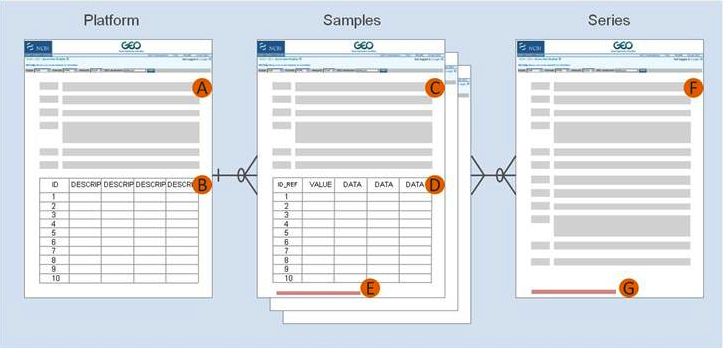Submitting data
GEO accepts many categories of high-throughput functional genomic data, including all array-based applications and some high-throughput sequencing data. This page summarizes deposit options and formats.
We aim to make data deposit procedures as straightforward as possible and will provide as much assistance as you require to get your data submitted to GEO. If you have problems or questions about the submission procedures, just e-mail us at geo@ncbi.nlm.nih.gov with a brief description of the type of data you are trying to submit, and one of our curators will quickly get back to you.
-
Submitting array data
-
Array deposit options
All the array deposit options described on this page are suitable for any type of array data. However, submitters who use the 4 common commercial arrays are advised to see these additional guidelines:
- Basic requirements for array submissions
- Fast facts about array data submissions
-
Array deposit options
- Submitting real time PCR data
- Submitting high-throughput sequence data
Array deposit options
The table below summarizes GEO array deposit options and formats. Deciding which method to use depends on the amount of data you have to submit, the format in which your data currently exist, and what applications you are familiar with. Regardless of the deposit method you choose, your final GEO records will look the same and contain equivalent information.
| Option | Format | Key points | |
|---|---|---|---|
| GEOarchive | spreadsheets (e.g., Excel) |
Recommended method for most submissions. Quickly describe your study using Excel spreadsheet templates. Complete instructions » |

|
| Web form deposit | web forms |
Interactive web forms - use only if you have a very small number of Samples to submit.
It may be necessary to edit your data tables to comply with web upload requirements. Complete instructions » |

|
| SOFT | plain text |
Good option if your data and metadata are already in a database,
and you can generate and export data in SOFT plain text format. Complete instructions » |

|
| MINiML | XML |
Good option if your data and metadata are already in a database,
and you can generate and export data in MINiML XML format. Complete instructions » |

|
All 4 array deposit options described above can be used for any array type. However, the majority of GEO submitters use common commercial arrays (Affymetrix, Agilent, Illumina or Nimblegen) each of which has unique properties and file types. It is recommended that submitters who use the 4 common commercial arrays also see these recommendations:
Basic requirements for array submissions
Your final GEO records will look something as follows:

For almost all array data submissions, you will be asked to provide the following information:
| A | Text description of your array | Platform submission is not necessary if your array is already in GEO (e.g., Affymetrix chips). In this case, all you need is a reference to the Platform accession number (GPLxxx). Use the FIND PLATFORM tool to locate arrays. |
|---|---|---|
| B | Text tab-delimited table of the array template | |
| C | Text description of a biological sample | |
| D |
Text tab-delimited table of processed hybridization result (may optionally include raw data columns) |
For Affymetrix data, a CHP file may be supplied instead of a tab-delimited table (but if you generate/analyze RMA or other non-CHP files, we recommend providing those rather than CHP files). |
| E | Original raw data file | External raw data files, e.g., Affymetrix CEL files or GenePix GPR files. |
| F | Text description of the overall experiment | |
| G | Original raw data file | External raw data files, e.g., Affymetrix CEL files or GenePix GPR files. |
Fast facts
- All the deposit methods described above support MIAME-compliant data submissions. More...
- Regardless of the deposit method you choose, the final GEO records will look the same and contain equivalent information.
- Your GEO submissions may remain private until a manuscript describing the data is published. More...
- You can allow reviewers anonymous access to your private submissions. More...
- GEO accession numbers are normally approved within 5 business days after completion of submission. If you do not receive an e-mail from us within 5 business days of your submission, please first check your spam or junk e-mail folders because some systems recognize GEO e-mail correspondence as spam, then e-mail us at geo@ncbi.nlm.nih.gov to inquire about your submission. More...
- All the deposit methods described above support submission of many data types, including:
- For all studies involving human subjects, it is the submitter's responsibility to ensure that the data and files supplied to GEO protect participant privacy in accordance with all applicable laws, regulations and institutional policies. Make sure to remove any direct personal identifiers from your submission. These identifiers are listed in http://privacyruleandresearch.nih.gov/research_repositories.asp, footnote 1.
- You can update or edit your existing GEO records at any time using any of the formats described above, and regardless of the format in which they were originally uploaded. More...

